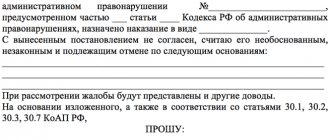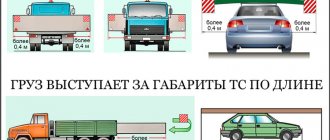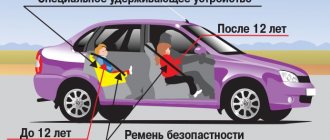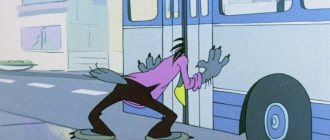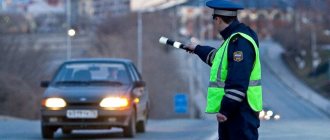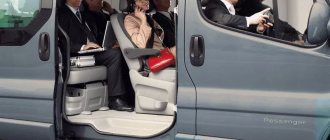Requirements for the driver
According to the rules for transporting people in the back of a truck, the driver cannot transport passengers (including loaders going to the site!) unless he has a document confirming the right to drive vehicles of the following categories:
- “C” – category (can transport up to 8 people, including passengers in the cabin)
- “C”, “C1”, “D1” – categories (can transport up to 16 people)
- “D” – category (more than 16 people can be transported)
In addition, the driver must have more than three years of experience driving cars falling into these categories.
Transportation of people - traffic rules 2021
22.1. Transportation of people in the back of a truck must be carried out by drivers who have a license to drive vehicles of category “C” (when transporting more than 8 people, including passengers in the cabin, categories “C” and “D”) and experience driving vehicles of this category more than 3 years.
Note
Military drivers are allowed to transport people in trucks in accordance with the established procedure.
22.2. Transporting people in the back of a flatbed truck is permitted if it is equipped in accordance with the Basic Provisions, but transporting children is not permitted.
22.2.1 Transportation of people on a motorcycle must be carried out by a driver who has a driver’s license for the right to drive vehicles of category “A” or subcategory “A1” for 2 or more years; transportation of people on a moped must be carried out by a driver who has a driver’s license for the right to drive vehicles of any category or subcategories for 2 or more years.
22.3. The number of people transported in the back of a truck, as well as in the cabin of a bus carrying out transportation on an intercity, mountain, tourist or excursion route, and in the case of organized transportation of a group of children, should not exceed the number of seats equipped for sitting. (as amended by Decree of the Government of the Russian Federation dated January 24, 2001 N 67)
22.4. Before the trip, the driver of the truck must instruct passengers on the procedure for boarding, disembarking and placing in the back.
You can start moving only after making sure that the conditions for the safe transportation of passengers are provided.
22.5. Travel in the back of a truck with a flatbed that is not equipped for transporting people is permitted only to persons accompanying the cargo or following its receipt, provided that they are provided with a seat located below the level of the sides.
22.6. Organized transportation of a group of children must be carried out in accordance with special rules in a bus or truck with a van body designed for transporting people. When transporting a group of children in an organized manner, an adult accompanying person(s) must be with them. Transporting standing children is prohibited. (clause 22.6 as amended by Decree of the Government of the Russian Federation dated February 16, 2008 N 84)
22.7. The driver is obliged to board and disembark passengers only after the vehicle has come to a complete stop, and to start driving only with the doors closed and not open them until the vehicle has come to a complete stop.
22.8. It is prohibited to transport people:
- outside the cabin of a car (except for cases of transportation of people in the back of a truck with a flatbed or in a van), tractor, other self-propelled vehicles, on a cargo trailer, in a caravan trailer, in the back of a cargo motorcycle and outside the seating areas provided for by the design of the motorcycle;
- in excess of the amount provided for by the technical characteristics of the vehicle. (as amended by Decree of the Government of the Russian Federation dated December 14, 2005 N 767)
The paragraph has been deleted. — Decree of the Government of the Russian Federation of December 14, 2005 N 767.
22.9. Transportation of children is permitted provided that their safety is ensured, taking into account the design features of the vehicle.
Transportation of children under 12 years of age in vehicles equipped with seat belts must be carried out using child restraints appropriate for the weight and height of the child, or other means that allow the child to be fastened using seat belts provided for by the design of the vehicle, and in the front seat passenger car - only with the use of child restraints. (as amended by Decree of the Government of the Russian Federation dated May 10, 2010 N 316)
It is prohibited to transport children under 12 years of age on the back seat of a motorcycle. (clause 22.9 introduced by Decree of the Government of the Russian Federation of December 14, 2005 N 767)
Vehicle requirements
According to traffic rules, to ensure the safety of passengers, the car body must be equipped in accordance with the following requirements:
- The seats must be securely fastened, and their height cannot exceed half a meter above the floor (and not lower than 0.3 m)
- The height of the side above the seats should not be less than 0.3 m
- Benches located at the back and sides should be equipped with reliable backs;
- The gap between benches should be 0.6 m
- Requires a roof over the body
- Working lighting must be installed inside
- It is mandatory to have a signal button to contact the driver of the car.
The presence of sharp elements inside the body is unacceptable; The edges of the seats and backrests must be smooth and non-hazardous. The staircase for passengers is installed on the rear side, to the right in relation to the movement of the car.
Side shutters “must” be in good condition and reliably protect the body from unexpected opening. For this, additional fixation is used.
Important: in the back you must have a fully equipped first aid kit and a working fire extinguisher.
Moral responsibility for the safety of children in the car
The rules were invented for a reason. Each point of the rules is aimed at two important tasks. The first is ensuring safety and order when transporting people. The second is filling the state budget. Therefore, it is better to use the first option of tasks and not fill the budget from your own pocket in the form of fines. This is an important point in the relationship between the police and drivers.
By violating the rules for transporting passengers, you create uncomfortable travel conditions, often damage your car, and most importantly, you endanger someone’s health and even life. Such risks are unacceptable, so it is worth observing the seemingly quite natural requirements of transportation. This is especially true for transporting children, because in this case the rules determine the following points:
- transportation of children under 12 years of age exclusively in special restraints;
- the restraint device is not a seat belt adapter;
- boosters also cannot serve as a full-fledged device for transporting a child;
- The child receives complete safety of movement only in a specially designed chair.
A child seat may seem like a real ordeal and an obscene purchase to many drivers. A good thing is very expensive, but it makes no sense to buy a low-quality one. That is why our drivers are offered various boosters and adapters that do not actually protect the child and do not ensure his safety in an accident.
The seats are designed in such a way that even in a serious accident they do not allow the child to fly out of it and damage vital parts of the body. Also, high-quality child seats resist deformation, protecting the baby’s head and abdomen in severe accidents. If you don’t believe in the effectiveness of the chairs, look at the photos and read the reviews of those who have actually experienced their reliability.
We invite you to watch an interview with a traffic police officer about the contradictions in the rules for transporting passengers, especially children:
Rules for passengers
Often, when moving to a new place of residence, people turn to transport companies to rent a truck. At the same time, wanting to “keep an eye” on the property being transported, some people prefer to accompany the cargo, sitting in the back during transportation.
This is not prohibited even in cases where the car body is not equipped with all the necessary devices that give the right to transport people in it. However, here you will have to follow some rules:
- Sharp and dangerous objects cannot be accompanied without packaging that guarantees their isolation
- While the vehicle is moving, it is prohibited to move around the body, especially not to hang over the walls or sit on the edges of the sides.
- The seat should be located at least 0.15 m below the side level
Naturally, the cargo must be securely secured inside the body using special devices.
All these rules are needed to minimize the risk to human life and health while riding in the back of a truck. If you are moving with the help of a reputable logistics organization, then its employees will definitely take care of your safety. If you cope with the move on your own, do not forget about these conditions. There is a fine for violation!
Amounts of fines for violating the rules for transporting passengers
The number of violations of the rules for transporting passengers in a passenger car has increased significantly. We strongly recommend that you do not limit yourself to reading an excerpt from the rules, but read all the updates in this Law, otherwise you will not have a complete understanding of the changes introduced.
Fines today have taken on new forms, becoming more terrifying and serious, which clearly motivates many drivers not to violate. Moreover, the integrity of traffic police officers also increases significantly, which becomes the reason for less and less pleasant interactions with police officers on the road. Therefore, it is better to remember the following numbers, meaning fines for incorrectly transporting passengers:
- a passenger with an unfastened seat belt will cost you 1,000 rubles, as well as 500 rubles for the passenger himself;
- if you carry an extra passenger, you will have to pay 500 rubles to the treasury for this violation;
- transporting people outside the car cabin (on the roof, hood or trunk lid) will cost the driver 1,000 rubles;
- Combined fines are possible; in this case, the most severe punishment does not work.
In many cases, the consequences of an offense are simplified by the fact that the most serious measure absorbs all others. That is, previously, if you committed a number of violations, the most expensive of which was punishable by fines of 2,000 rubles, you would have paid exactly two thousand, and not the total number of sanctions. Today, everything is much less interesting for the driver.
That is, the most unpleasant situation in this case will be if the person riding on the hood ends up sixth in a car with a maximum of five passengers, and is also not wearing a seat belt. Then the driver will have to learn all the features of the new edition of the rules. You may think that such situations are generally impossible, but there are already precedents for imposing such fines.
Rights and obligations of passengers
You should not focus solely on parameters that relate to vehicles or the professional qualities of the driver. Passengers, as full-fledged road users, also have certain rights, among which are the opportunity to:
- Require the transport company to provide paid services for transportation and carry-on luggage.
- Carry with you personal luggage within the weight limits established by the rules (free of charge or at a tariff).
- Request, in accordance with Russian legislation, compensation for damage to life, health and property caused during transportation.
- Receive the most complete information about the operation of transport and the conditions for transporting passengers.
On the other hand, the client of a taxi, bus or other public transport vehicle has a clearly defined list of obligations, which are also enshrined at the legislative level. Thus, each passenger is obliged, within the agreed time frame of the trip:
- pay for transportation services and carrying rune luggage in excess of the norm;
- comply with the rules for using a certain type of transport;
- have a document that confirms the child’s age or benefits;
- keep the ticket until the end of the route (except for tokens).
There are also other rights and obligations of the passenger, but they are already established separately on the basis of related rules for the operation of vehicles, and therefore are communicated upon request.
